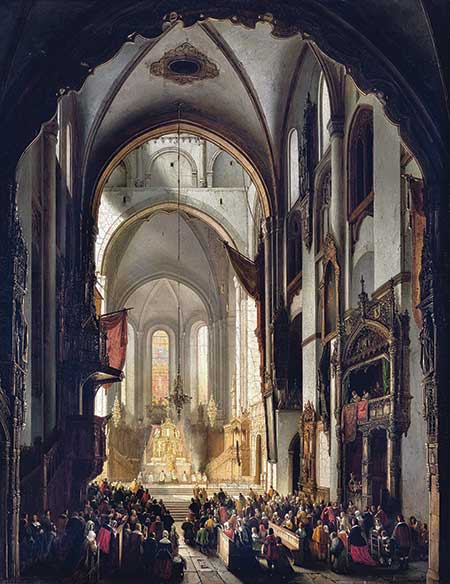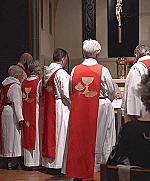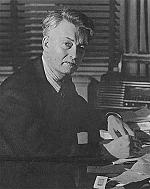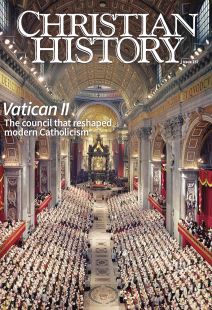A tale of two liturgies

[George Gillis Haanen, Kircheninterieur. 1849. Oil on canvas—Dorotheum / Public domain, Wikimedia]
After Vatican II the Novus Ordo (New Order), often called the Ordinary Form or the Mass of Paul VI, incorporated insights and decrees from the council’s documents as well as other liturgical research. It is almost always celebrated in the vernacular, though a Latin form of it exists. The previous Tridentine liturgy is now called the Extraordinary Form (because special permission is needed to celebrate it) and is invariably celebrated in Latin.
Here is how the Mass begins in each liturgy. (The + indicates a place where priest or people cross themselves.) The Ordinary Form gives a number of options at each point; some of the most common ones have been chosen here.
Extraordinary Form
[Instruction to the congregants] Kneel.
The priest, bowing down at the foot of the altar, makes the Sign of the Cross and says:
In nómine Patris, et Fílii, + et Spíritus Sancti. Amen. (In the Name of the Father, + and of the Son, and of the Holy Ghost. Amen.)
Then joining his hands before his breast, he begins the Anthem:
Introíbo ad altáre Dei. (I will go in unto the Altar of God.)
[Server] Ad Deum qui lætíficat juventútem meam. (To God, Who giveth joy to my youth.)
[In most masses Psalm 42 follows, said in Latin and alternating verses between priest and altar server. It is omitted here for space. Afterward:]
The priest, signing himself with the Sign of the Cross, says:
Adjutórium nostrum + in nómine Dómini. (Our help + is in the Name of the Lord.)
[S.] Qui fecit cælum et terram. (Who hath made heaven and earth.)
Then, joining his hands and humbly bowing down, he says the Confiteor:
Confiteor Deo omnipoténti, etc. (I confess to Almighty God, etc.)
[S.] Misereátur tui omnípotens Deus, et dimíssis peccátis tuis, perdúcat te ad vitam ætérnam. (May Almighty God have mercy upon you, forgive you your sins, and bring you to life everlasting.)
The server says the Confiteor:
[S.] Confíteor Deo omnipoténti, beátæ Maríæ semper Vírgini, beáto Michaéli Archángelo, beáto Joanni Baptístæ, sanctis Apóstolis Petro et Paulo, ómnibus Sanctis, et tibi, Pater: quia peccávi nimis cogitatióne, verbo et ópere: [he strikes his breast three times] mea culpa, mea culpa, mea máxima culpa. Ideo precor beátam Maríam semper Vírginem, beátum Joánnem Baptístam, sanctos Apóstolos Petrum et Paulum, omnes Sanctos, et te, Pater, oráre pro me ad Dóminum Deum nostrum. (I confess to Almighty God, to blessed Mary ever Virgin, to blessed Michael the Archangel, to blessed John the Baptist, to the holy Apostles Peter and Paul, to all the Saints, and to you Father, that I have sinned exceedingly, in thought, word and deed: [he strikes his breast three times] through my fault, through my fault, through my most grievous fault. Therefore I beseech blessed Mary ever Virgin, blessed John the Baptist, the holy Apostles Peter and Paul, all the Saints, and you Father, to pray to the Lord our God for me.)
[S.] Misereátur tui omnípotens Deus, et dimíssis peccátis tuis, perdúcat te ad vitam ætérnam. (May Almighty God have mercy upon you, forgive you your sins, and bring you to life everlasting.)
[P.] Amen.
[The priest] bows his head and proceeds:
Deus, tu convérsus vivificábis nos. (Thou wilt turn, O God, and bring us to life.)
[S.] Et plebs tua lætábitur in te. (And Thy people shall rejoice in Thee.)
[P.]Osténde nobis, Dómine, misericórdiam tuam. (Show us, O Lord, Thy mercy.)
[S.] Et salutáre tuum da nobis. (And grant us Thy salvation.)
[P.] Dómine, exáudi oratiónem meam. (O Lord, hear my prayer.)
[S.] Et clamor meus ad te véniat. (And let my cry come unto Thee.)
[P.] Dóminus vobíscum. (The Lord be with you.)
[S.] Et cum spíritu tuo. (And with thy spirit.)
Ordinary Form
Entrance Song
Stand
The Entrance Song of the day is said. If desired, another Psalm or hymn of similar spirit may be used in its place. The priest comes to the altar, he makes the customary reverence with the ministers, kisses the altar and (if incense is used) incenses it. Then, with the ministers, he goes to
the chair.
Greeting
Priest: +In the name of the Father, and of the Son, and of the Holy Spirit.
People: Amen.
Priest: The grace of our Lord Jesus Christ and the love of God and the fellowship of the Holy Spirit be with you all.
People: And also with you.
The priest, deacon, or other suitable minister may very briefly introduce the Mass of the day.
Penitential Rite
After the introduction to the day’s Mass, the priest
invites the people to recall their sins and to repent of them
in silence.
Priest: My brothers and sisters, to prepare ourselves to celebrate the sacred mysteries, let us call to mind
our sins.
A pause for silent reflection follows. After the silence, one of the following three forms is chosen.
People: I confess to almighty God, and to you, my brothers and sisters, that I have sinned through my own fault [they strike their breasts] in my thoughts and in my words, in what I have done, and in what I have failed to do; and I ask blessed Mary, ever virgin, all the angels and saints, and you, my brothers and sisters, to pray for me to the Lord our God.
Priest: May almighty God have mercy on us, forgive us our sins, and bring us to everlasting life.
People: Amen.
Or:
Priest: Lord we have sinned against you:
People: Lord, have mercy.
Priest: Lord, show us your mercy and love.
People: And grant us your salvation.
Priest: May almighty God have mercy on us, forgive us our sins, and bring us to everlasting life.
People: Amen.
Or this:
Priest: You were sent to heal the contrite: Lord, have mercy.
People: Lord, have mercy.
Priest: You came to call sinners: Christ, have mercy.
People: Christ, have mercy.
Priest: You plead for us at the right hand of the Father: Lord, have mercy.
People: Lord, have mercy.
Priest: May almighty God have mercy on us, forgive us our sins, and bring us to everlasting life.
People: Amen.
By Adapted from the Liturgy Archive
[Christian History originally published this article in Christian History Issue #157 in 2025]
Next articles
“The effect was electrifying”
How Vatican II influenced one Protestant denomination
Jennifer Woodruff TaitReformers of Rome
Some Catholic leaders who influenced Vatican II
Jennifer A. Boardman and Edward Woodruff TaitSupport us
Christian History Institute (CHI) is a non-profit Pennsylvania corporation founded in 1982. Your donations support the continuation of this ministry
Donate







